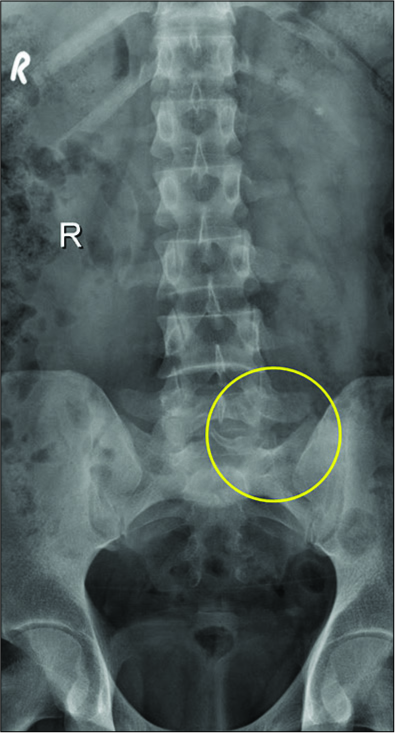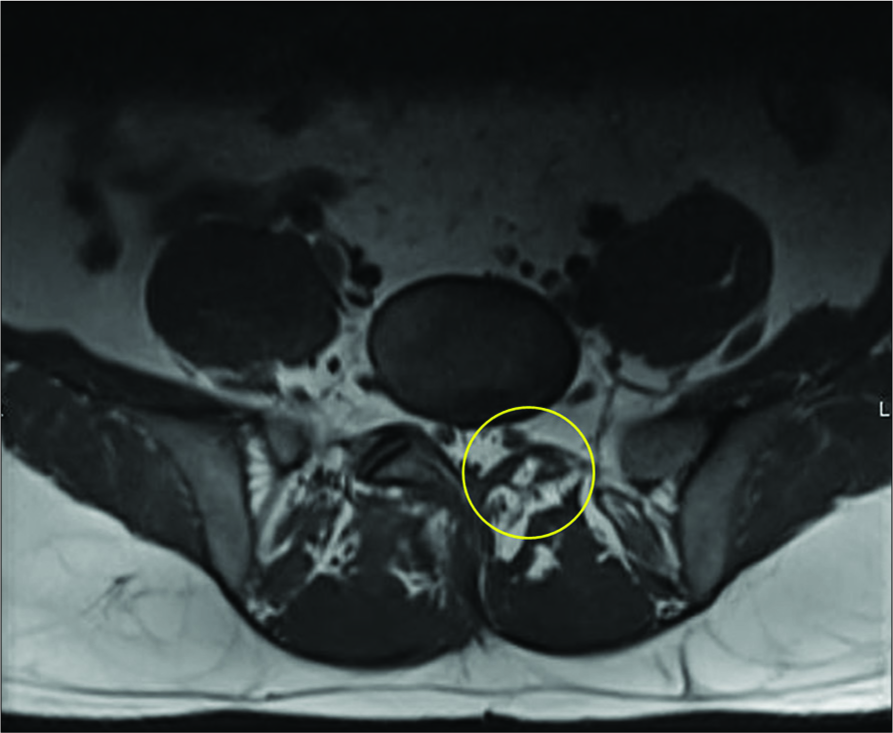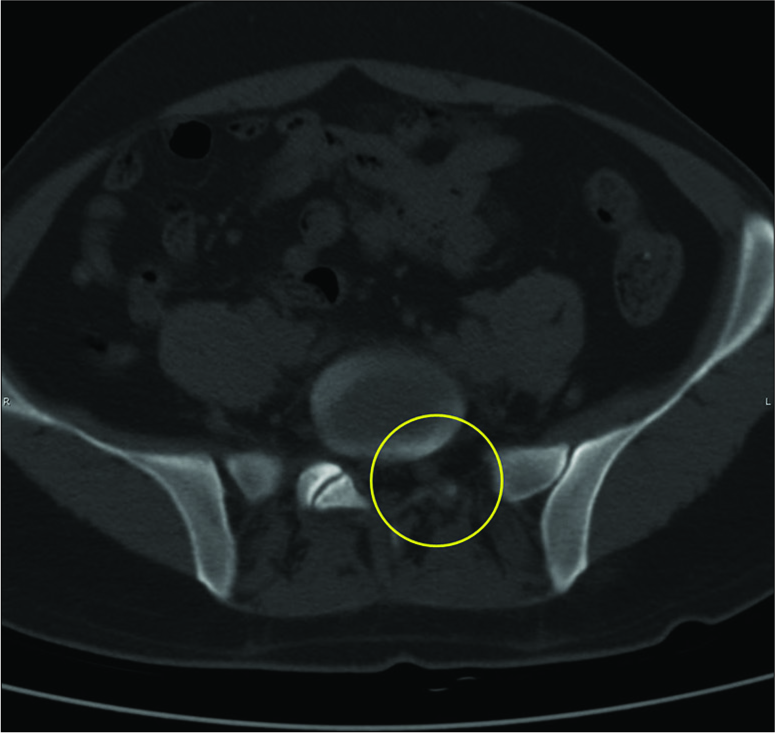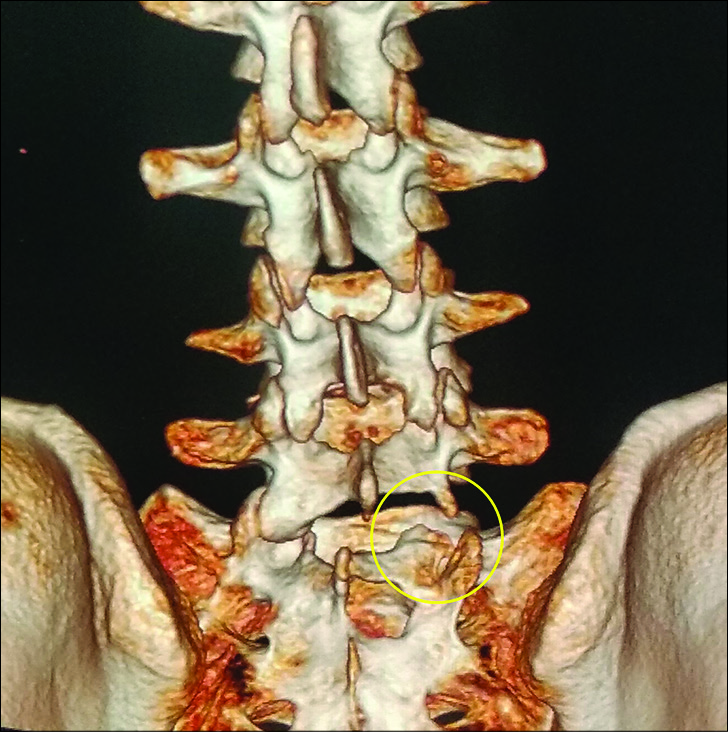- Department of Ortho Spine Surgery, Sir Ganga Ram Hospital, New Delhi, Delhi.
DOI:10.25259/SNI_606_2019
Copyright: © 2020 Surgical Neurology International This is an open-access article distributed under the terms of the Creative Commons Attribution-Non Commercial-Share Alike 4.0 License, which allows others to remix, tweak, and build upon the work non-commercially, as long as the author is credited and the new creations are licensed under the identical terms.How to cite this article: Nitin Maruti Adsul, Manoj Kumar, Shankar Acharya, K. L. Kalra, R. S. Chahal. Congenital absence of a lumbosacral facet joint: A case report. 24-Jan-2020;11:15
How to cite this URL: Nitin Maruti Adsul, Manoj Kumar, Shankar Acharya, K. L. Kalra, R. S. Chahal. Congenital absence of a lumbosacral facet joint: A case report. 24-Jan-2020;11:15. Available from: https://surgicalneurologyint.com/surgicalint-articles/9854/
Abstract
Background: Congenital absence of the lumbosacral facet joint is extremely rare, with only 26 cases reported in the literature. Here, we present a patient with the unilateral absence of the left fifth lumbar inferior articular process and reviewed the relevant literature.
Case Description: A 32-year-old gentleman, who had undergone right L4-5 lumbar microdiscectomy 3 months ago now presented with acute low back and left leg pain following a fall. He is now presented with acute low back and left leg pain following a fall. Plain radiographs of the L-S spine revealed an absent left L5–S1 zygapophyseal joint. The magnetic resonance imaging and computed tomography studies additionally confirmed an absent unilateral left L5 lumbar inferior articular process.
Conclusion: Patients presenting for lumbar surgery may have unilaterally absent lumbosacral zygapophyseal joints, which may impact the outcome of surgical treatment.
Keywords: Congenital absence, Facet joint, Lumbosacral
INTRODUCTION
Congenital absence of the lumbosacral facet joint, most typically involving the L5–S1 level, is extremely rare, having been reported in just 26 cases.[
CASE REPORT
Three months ago, a 32-year-old male had a right L4–L5 lumbar microdiscectomy. Two months ago, he sustained a fall and developed acute left lower extremity sciatica accompanied by positive left-sided 40 degree SLR, and weakness in the left extensor hallucis longus distribution (MRC 4/5). Plain X-rays documented the prior right side L4–L5 hemilaminotomy defect and the absent left L5-S1 zygapophyseal joint [
DISCUSSION
Congenital absence of the lumbar facet joint is extremely rare; typically, 80% involve the L5–S1 level.[
CT scans along with 3D reconstruction best document these lesions. MRI may additionally confirm further pathological changes, for example, nerve root anomaly (conjoined nerve root),[
Clinical presentation
These patients are typically asymptomatic, while others may have mild low back pain easily treated with conservative measures. The cases with a neurological deficit due to spinal instability may be surgically managed, for example, with decompression and/or fusions. Due to the small number of cases reported, the treatment of these lesions remains controversial.[
CONCLUSION
Following a unilateral laminotomy, recurrent contralateral symptoms may be attributed to a new contralateral disc herniation in conjunction with the congenital absence of the contralateral lumbosacral zygapophyseal joint.
Declaration of patient consent
Patient’s consent not obtained as patient’s identity is not disclosed or compromised.
Financial support and sponsorship
Nil.
Conflicts of interest
There are no conflicts of interest.
Acknowledgment
We would like to thank Dr. Chand Sahai, Senior Anesthesiologist, as part of our surgical team and for correcting grammatical mistakes in manuscript.
References
1. Kaito T, Kato Y, Sakaura H, Yamamoto K, Hosono N. Congenital absence of a lumbar pedicle presenting with contralateral lumbar radiculopathy. J Spinal Disord Tech. 2005. 18: 203-5
2. Maalouly J, Aouad D, Abd El Nour HG, Nehme A, Jabbour F. Isolated congenital absence of lumbosacral facet joint. Case Rep Orthop. 2019. 2019: 1465460-
3. Oh YM, Eun JP. Congenital absence of a cervical spine pedicle: Report of two cases and review of the literature. J Korean Neurosurg Soc. 2008. 44: 389-91
4. Wang Z, Sakakibara T, Kasai Y. Congenital absence of the lumbar facet joint associated with bilateral spondylolysis of the fifth lumbar vertebra. Neurol Med Chir (Tokyo). 2013. 53: 118-21
5. Yoshioka S, Sairyo K, Sakai T, Yasui N. Congenital absence of lumbosacral articular facet joint associated with conjoined nerve root: A case report. J Orthop Traumatol. 2010. 11: 183-7










